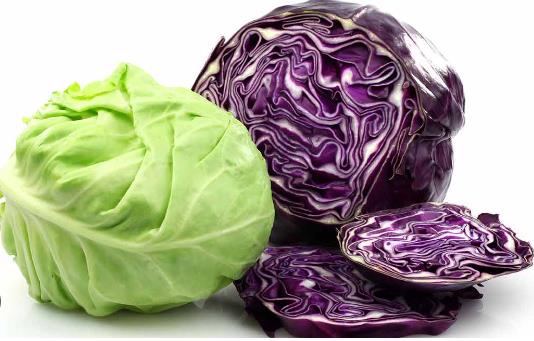
10 Benefits of Purple Cabbage: for Skin, Weight Loss, Health, and More
Purple cabbage also known as red cabbage takes its name from its vibrant purple hue that makes it look beautiful. The good news is that is not only visually great but also helpful in maintaining the health of your organs. It comes from the brassica family and is most commonly found in Europe, America, China, and Africa.
It is more beneficial than the green cabbage and also tastes different. Curious about this beautiful globe-like vegetable? We are here to answer all your curiosities and tell you some amazing benefits of adding it to your diet.
Purple cabbage offers unique flavors and nutritional benefits that can enhance your overall health and culinary experience.
Table of Contents:
- Part 1: Nutrients in Purple Cabbage
- Part 2: How is Purple Cabbage Different from Green Cabbage?
- Part 3: Benefits of Purple Cabbage
- Part 4: Some Delicious and Healthy Purple Cabbage Recipes
- Part 5: What Are the Side Effects of Purple Cabbage
Part 1: Nutrients in Purple Cabbage

Purple cabbage is highly nutritious and greatly known for its exceptional benefits for the skin, health, and various diseases. Let’s see what nutrients in purple cabbage make it a valuable vegetable for you.
Purple cabbage is not only delicious but also packed with essential nutrients that contribute to overall well-being.
Vitamins: Purple cabbage is rich in Vitamin A, Vitamin K, and Vitamin B6. These vitamins are essential for maintaining your bone, skin, and organs health.
Vitamins play a crucial role in various bodily functions, and incorporating purple cabbage into your diet can support your health goals.
Fibers: 89 grams of raw purple cabbage contains 2 grams of fiber. Fibers are usually good for maintaining the health of your gut by keeping the colon cells healthy.
Fiber intake is vital for a healthy digestive system, and purple cabbage is a tasty way to increase your fiber consumption.
Antioxidants: Purple cabbage also contains antioxidants in the form of Vitamin C, carotenoids, anthocyanins, and kaempferol.
Antioxidants in purple cabbage may help combat oxidative stress, promoting better health and potentially reducing the risk of chronic diseases.
Part 2: How is Purple Cabbage Different from Green Cabbage?

Most people are only aware of green cabbage but there are also purple cabbage. They are closely related but have some differences which makes purple cabbage superior to green cabbage. Let’s see how purple cabbage is different from the green one.
- They taste different. Purple cabbage has more of a strong peppery taste while green cabbage has a mild flavor that can even be eaten raw
- Purple cabbage has more nutritional value as compared to red cabbage as it is 10 times richer in Vitamin A as compared to green cabbage
The flavor differences between purple and green cabbage can enhance a variety of dishes, making each unique in taste and presentation.
Nutritional value is an important consideration when choosing vegetables, and purple cabbage stands out for its rich vitamin content.
Part 3: Benefits of Purple Cabbage
A single ingredient can solve so many of your problems. Being rich in a number of nutrients, it provides you with exceptional health results. So, are you ready to know what possible benefits you can get from it by making it a part of your healthy daily routine? Let’s start.
1. Anti-Inflammatory Agent

Purple cabbage contains sulforaphane which is a good anti-inflammatory agent. Animal studies reported a reduction in inflammation caused by sulforaphane [1]. The reduction in inflammation can occur both by eating the cabbage and its application on the skin.
Wrapping the cabbage leaves around the knees of arthritis patients can help reduce their pain Additionally, in early postpartum, cabbage can also reduce breast inflammation and pain caused by increased milk production.
Cabbage wraps can be an effective natural remedy for inflammation, offering relief for those dealing with pain and discomfort.
2. Good for Heart
The anthocyanins present in purple cabbage have the potential to prevent a number of heart diseases and even Alzheimer’s [2]. In addition to this, the Vitamin C can help in increasing the production of collagen.
Anthocyanins may offer protective benefits for cardiovascular health and neuroprotection, making purple cabbage a valuable addition to your diet.
This increased collagen production strengthens the walls of the heart which can help reduce the risk of atherosclerosis.
Strengthening heart walls can significantly reduce the risk of heart-related issues, emphasizing the importance of collagen in cardiovascular health.
3. Strengthens the Bones
Purple cabbage is one of the few vegetables that can help in improving the health of your bones and providing them strength. Other than Vitamin D and Calcium, our bones also need Vitamin K, zinc, and magnesium.
Vitamin K, zinc, and magnesium are crucial for maintaining bone density and overall skeletal strength, making purple cabbage a beneficial choice for bone health.
The addition of purple cabbage to your diet can fulfill all these deficiencies and help our bones stay healthy and strong for a long time.
Addressing nutrient deficiencies is vital for long-term bone health, and purple cabbage can effectively contribute to this goal.
4. Improves Gut Health

Fibers are essential for your gut so that digestion can be easy and your bowel movements remain regular and smooth. Moreover, the fibers can also help treat diarrhea and constipation.
Dietary fiber plays a key role in promoting digestive health, helping to maintain regularity and alleviate gastrointestinal issues.
At the start of the article, we discussed the high quantity of fibers in purple cabbage. So, adding it to your diet can help you keep the digestion smooth.
Integrating fiber-rich foods like purple cabbage can enhance digestive function, supporting a healthy gut environment.
5. Anti-cancerous
Purple cabbage can help in the prevention of some cancers like colon, breast, and bladder cancer. Studies have shown that cruciferous vegetables can decrease the risk of breast cancer and sulforaphane present in them can stop the spread of cancer in the body [3].
Purple cabbage is one of the cruciferous vegetables and is rich in sulforaphane, so it is believed that it can be anti-cancerous.
Sulforaphane's presence in purple cabbage underscores its potential role in cancer prevention, making it a noteworthy vegetable for health-conscious individuals.
6. Beneficial in Preganancy
If you are pregnant and looking for some healthy vegetables, you can add purple cabbage to your list.
Rich in essential nutrients, purple cabbage can support the health of both the mother and the developing fetus during pregnancy.
The Vitamin and minerals present in it can help in producing more red blood cells. Additionally, purple cabbage also contains Vitamin A which is good for healthy skin, improved vision, and the development of the immune system. There can be some contraindications so it is best to consult your doctor or a dietician about the right amount of cabbage in your diet.
Another beneficial item for your pregnancy can be the raspberry leaf tree. Want to know about it? Click, Raspberry Leaf Tea Benefits for Females
7. Lowers Blood Pressure and Cholesterol Level

Those with problems of high blood pressure can rely on purple cabbage. It is rich in quercetin and kaempferol, bioflavonoids, which are highly potent against the prevention of stroke and heart diseases by lowering blood pressure. The carotenoids in purple cabbage also decrease your blood pressure.
The phytochemicals along with the fibers in cabbage lower cholesterol, Moreover, isoflavones block the enzymes responsible for stimulating cholesterol production.
Lowering cholesterol levels can contribute to overall cardiovascular health, making this benefit particularly significant for those at risk of heart disease.
8. Provides Migraine Relief
A natural way to reduce your extreme headaches and migraines is the use of purple cabbage. It does this by reducing the inflammation of your blood vessels and fulfilling the deficiency of Vitamin K. Vitamin K is seen to be lower in patients with migraine [4].
Furthermore, magnesium intake can help in relieving the headache and purple cabbage is also a great source of magnesium.
Magnesium is known for its role in muscle relaxation and stress reduction, which may further enhance its effectiveness in migraine relief.
9. Helps in Weight Loss
Struggling with the weight loss? Purple cabbage is your answer. They have high water content, a high quantity of anti-oxidants, various vitamins, and dietary fibers, and still low in calories.
High in dietary fiber, purple cabbage can also improve digestion, which is an important aspect of any weight loss plan.
You can add it to your salad, juice the cabbage juice, or cook it and eat it with other grilled vegetables. This makes it a great partner in your journey of weight loss.
10. Improves Skin Health
With purple cabbage, you can maintain the health of your internal organs which shows on your face. Your face glows when are healthy and taking care of your diet and daily routine.
Healthy internal organs can lead to a more vibrant appearance, underscoring the connection between diet and skin health.
Being a good source of antioxidants, the purple cabbage keeps your skin free of wrinkles, and dullness and fights against free radicals. Additionally, Vitamin C brightens your skin tone and helps reduce hyperpigmentation.
Antioxidants play a crucial role in fighting skin aging, making purple cabbage a valuable addition to any skincare routine.
Other than cabbage, carrots can also help your skin. To know more, read 10 Benefits of Carrot for Skin
Part 4: Some Delicious and Healthy Purple Cabbage Recipes
Eating raw purple cabbage alone or cooking it in traditional ways can be boring for some people. So, you can try some purple cabbage recipes by mixing different ingredients together to make your diet both fun and delicious.
Exploring various recipes can enhance your enjoyment of purple cabbage, making it a versatile addition to your meals.
1. Coleslaw

The coleslaw is light, healthy, and easy to make. Let’s see what you need
Coleslaw is a classic dish that can be customized with various dressings and toppings to suit your taste.
Ingredients: 2 cups of slices purple and green cabbage each, 2 cups of carrot, ¾ cup of seeds mixture (sunflower, sesame, pumpkin seeds), one-quarter of parsley, half teaspoon of ground cumin and salt each, 2 tablespoons of lemon juice, one-quarter olive oil, and 1 clove minced garlic
To do: Toast your seeds on medium heat until you hear popping sounds. Set them aside. Take a bowl and mix lemon juice, garlic, olive oil, cumin, and salt in it. Now mix the seeds, vegetables, and lemon mixture in a bigger bowl and enjoy your coleslaw.
2. Sauteed Purple Cabbage

Sauteed Purple cabbage is a quick, easy-to-make, and flavourful recipe. Just follow these instructions
Sauteed purple cabbage can be served as a side dish or added to other meals for a burst of flavor and nutrition.
Ingredients: 2 tablespoons of olive oil, half purple cabbage, 1 small sliced onion, ⅓ spoon of white vinegar, 2 tablespoons of sugar, 1 teaspoon of mustard seeds, and some salt and pepper.
To do: Take a skillet and heat it on medium-high heat. Add onion and saute it for 2 minutes and then add cabbage. After cooking for a further 5 minutes, add sugar and mix well. Now, add salt, pepper, and mustard and cook it for 15 minutes.
3. Purple Cabbage Juice

Purple cabbage juice benefits your skin and gut. Moreover, a tasty cabbage juice can be your favorite drink after a hectic, tiresome day.
Drinking purple cabbage juice regularly may support your overall wellness and can be a refreshing option to include in your diet.
Ingredients: 300g of purple cabbage, 1 medium peeled beet, and 3 medium peeled oranges
To do: Add these ingredients to a juicer and blend them well. Take a glass, pour the juice, and you are ready to enjoy your delicious and healthy juice.
Making this juice is simple and can be a delightful way to incorporate more vegetables into your daily routine.
Part 5: What Are the Side Effects of Purple Cabbage
Although purple cabbage is beneficial in so many ways, an uncontrolled amount can cause some side effects. However, its use is also contraindicated in some people. This section explains all the possible side effects and some contraindications related to the use of purple cabbage.
1. Interferes with Thyroid Gland Functioning
Purple cabbage is a source of goiterogens which can enlarge your thyroid gland and interfere with its normal functioning [5]. So, use it in a certain amount. Furthermore, if you have hypothyroidism or any other condition related to the thyroid gland, consult your doctor before using cabbage or any other cruciferous vegetable.
2. Flatulence
The cabbage contains an indigestible sugar known as Raffinose whose over-intake can cause flatulence and gas in your stomach. Also, when you chew cabbage, it releases a sulfur-containing compound-glucosinolate. The bacteria in your stomach reduces these into hydrogen sulfide which leads to gas and smelly farts.
3. A Bad Combination for Blood Thinning Medications
The Vitamin K present in purple cabbage can reduce the efficiency of blood-thinning medications like warfarin. So, if you are taking any of these medications, consult your healthcare provider before using purple cabbage.
Vitamin K is important for many bodily functions, so it's essential to be mindful of its interaction with medications.
4. Allergy
If you are allergic to broccoli, cauliflower, and other vegetables from the brassica family, then purple cabbage might also cause an allergic reaction. So, before eating the vegetable, make sure you are not allergic to it. These allergies are usually confirmed by IgE antibody tests. You can get it done in case you have allergies to other Brassica family vegetables.
Conclusion
Purple cabbage takes its color from anthocyanins. It is also rich in vitamins A, C, K, antioxidants, and dietary fibers. Being highly nutritious and low in calories, the purple cabbage can help you decrease your weight and maintain it on a moderate level. Other than this, the purple cabbage keeps your heart, gut, skin, and blood vessels healthy.
To benefit from purple cabbage, you can add it to your diet in the form of coleslaw, sauteed cabbage, and even make a delicious juice by using oranges and cabbage. Before using it, the only thing you need to keep in mind is that you are not suffering from any thyroid gland disease, allergies, or blood conditions.

Should I Wash My Face in the Morning?

Is Rose Water Good for Your Face?

PCOS Facial Hair: Symptoms, Causes And How to Stop It
Need guidance?
















































